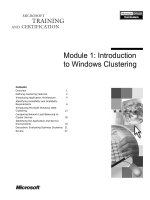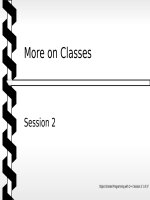Session 2: Introduction to Windows pot
Bạn đang xem bản rút gọn của tài liệu. Xem và tải ngay bản đầy đủ của tài liệu tại đây (262.3 KB, 41 trang )
Introduction to Windows/ Session
2/ 1 of 41
Introduction to Windows
Session 2
Introduction to Windows/ Session
2/ 2 of 41
Session Objectives
Explain the concept of an Operating System
Explain the concept of Networking
Explain workgroup and domain models
Identify features of Windows Operating
System family
Define some commonly used terminology
Explain concept of sharing in Windows
Introduction to Windows/ Session
2/ 3 of 41
Introduction to Operating Systems
“An operating system is a program that acts as an
interface between the user and the computer
hardware and controls the execution of all kinds of
programs.”
THE USER
Floppy disk Hard disk
Storage Devices
Output device
Printer / Monitor
THE OPERATING
SYSTEM
M
E
M
O
R
Y
The Control Unit / The ALU
Central Processing Unit
Input device
Keyboard
Introduction to Windows/ Session
2/ 4 of 41
Functions of an Operating System
It loads itself into memory.
It loads user program into memory.
It loads required data into memory.
It interprets program instructions.
Gives instruction to display results on screen.
It manages resources.
Introduction to Windows/ Session
2/ 5 of 41
Single-user system
Has a single CPU and one set of I/O devices.
Popular example - Microsoft Disk Operating
system or MS-DOS.
Introduction to Windows/ Session
2/ 6 of 41
Multi-user systems
More than one user can work on system
Each user could be working on different set of
programs and data
Central computer acts as server
Data and programs stored on server
All processing is done by server
Computers connected as nodes or workstations
function as dumb terminals or intelligent terminals
Common multi-user system is UNIX
Introduction to Windows/ Session
2/ 7 of 41
Introduction to Networking
“A computer network is a data communication network
wherein two or more computers and peripheral
devices are linked together”.
Connection may be permanent (where cables are
used) or temporary (through phone lines).
Various devices are connected through network
interface card (NIC).
Introduction to Windows/ Session
2/ 8 of 41
Illustration of a Computer Network
= Communication network node
= Network station
Communications network
Introduction to Windows/ Session
2/ 9 of 41
Uses of Networking
Centralised storage
Sharing data and resources
Remote database and program access
Communication
Economical
Introduction to Windows/ Session
2/ 10 of 41
Types of Network
Based on geographical location, networks can
be classified as:
Local Area Network (LAN)
Enterprise Networks
Wide Area Network (WAN)
Introduction to Windows/ Session
2/ 11 of 41
Components of a network
Network Operating System
Servers
•
File server
•
Database server
•
Archive server
•
Print server
Clients (nodes or workstations)
Cabling System
Shared resources and peripherals
Introduction to Windows/ Session
2/ 12 of 41
Workgroups and Domains
In Windows NT two prevalent modes of
grouping networked computers:
–
Workgroups
–
Domains
Introduction to Windows/ Session
2/ 13 of 41
Workgroup Model
Networked computers grouped physically or logically.
One or more of computers - shared resources.
Computers share peer-to-peer relationship.
Local account database.
Resources / administration distributed throughout
computers on workgroup.
Introduction to Windows/ Session
2/ 14 of 41
Workgroup Model (contd.)
Advantages
–
Simple design makes it easy to implement
–
Easy to share resources
–
Convenient for a limited number of users
Disadvantages
–
No centralised management
–
Duplication of accounts
–
Inefficient on a large network
Introduction to Windows/ Session
2/ 15 of 41
Domain Model
Networked computers are grouped logically.
One or more computer (s) having shared resources.
Centralised domain directory database contains user
accounts and security information of all users in that
domain.
All computers in domain share this database.
Introduction to Windows/ Session
2/ 16 of 41
Domain Model (contd.)
One of the computers is configured as central server
or primary domain controller (PDC).
The PDC maintains the centralised domain directory
database.
Typically an additional server is connected which acts
as backup domain controller (BDC).
Introduction to Windows/ Session
2/ 17 of 41
Domain Model (contd.)
Advantages
–
Centralised administration .
–
Security management is centralised.
Disadvantages
–
Administration is more complex.
–
Sharing resources is more complex.
Introduction to Windows/ Session
2/ 18 of 41
The World of Windows
Command line interface, users have to know
relevant DOS commands.
Windows - graphical user interface (GUI).
Initial versions of Windows rode on top of
DOS (Disk Operating System).
Windows 4.0 family of operating systems
combines operating system technology of
DOS and graphical user interface of earlier
versions.
Introduction to Windows/ Session
2/ 19 of 41
Windows Operating System
Windows Longhorn
Windows 2003
Windows XP
Windows 2000
Windows Me
Windows 98
Windows 95
Windows NT Workstation
Windows NT Server
Introduction to Windows/ Session
2/ 20 of 41
Windows Operating System family
(contd.)
Similarities
–
common user interface
–
features and utilities
–
32-bit operating systems
Introduction to Windows/ Session
2/ 21 of 41
Windows 2000 Professional
Features:
–
Easier to use
–
Easier to manage
–
More compatible
–
More powerful
Introduction to Windows/ Session
2/ 22 of 41
Features of Windows 2000
Professional(contd.)
Easier to use
With Windows 2000 Professional, you have faster
access to information, and you are able to
accomplish tasks more quickly and easily.
Windows 2000 Professional makes it easier to:
–
Work with files.
–
Find information.
–
Personalize your computing environment.
–
Work on the Web.
–
Work remotely.
Introduction to Windows/ Session
2/ 23 of 41
Features of Windows 2000
Professional(contd.)
Easier to manage
You and your network administrators can work more
efficently now, because many of the most common
computer-management tasks are automated and
streamlined with Windows 2000 Professional.
With Windows 2000, your workstation will be easier
to:
–
Set up.
–
Administer.
–
Support.
Introduction to Windows/ Session
2/ 24 of 41
Features of Windows 2000
Professional(contd.)
More compatible
Windows 2000 Professional offers increased
compatibility with different types of networks
and with a wide array of legacy hardware and
software.
Windows 2000 also provides:
–
Improved driver support.
–
Increased support for new-generation
hardware and multimedia technologies.
–
Integration of the new Euro currency
symbol.
Introduction to Windows/ Session
2/ 25 of 41
Features of Windows 2000
Professional(contd.)
More powerful
For all your computing needs,
Windows 2000 Professional provides:
–
Industrial-strength reliability.
–
The highest level of security.
–
Powerful performance.









